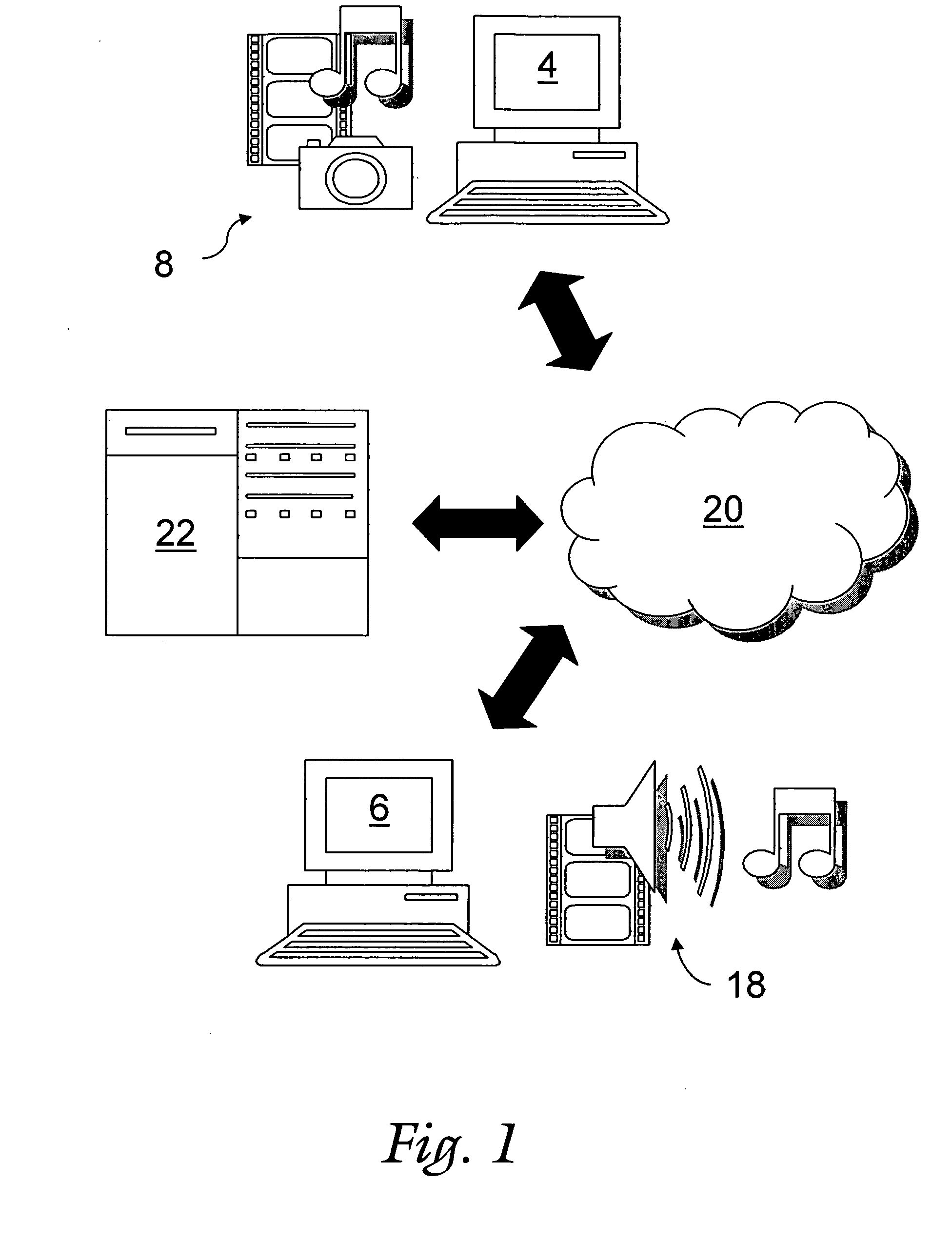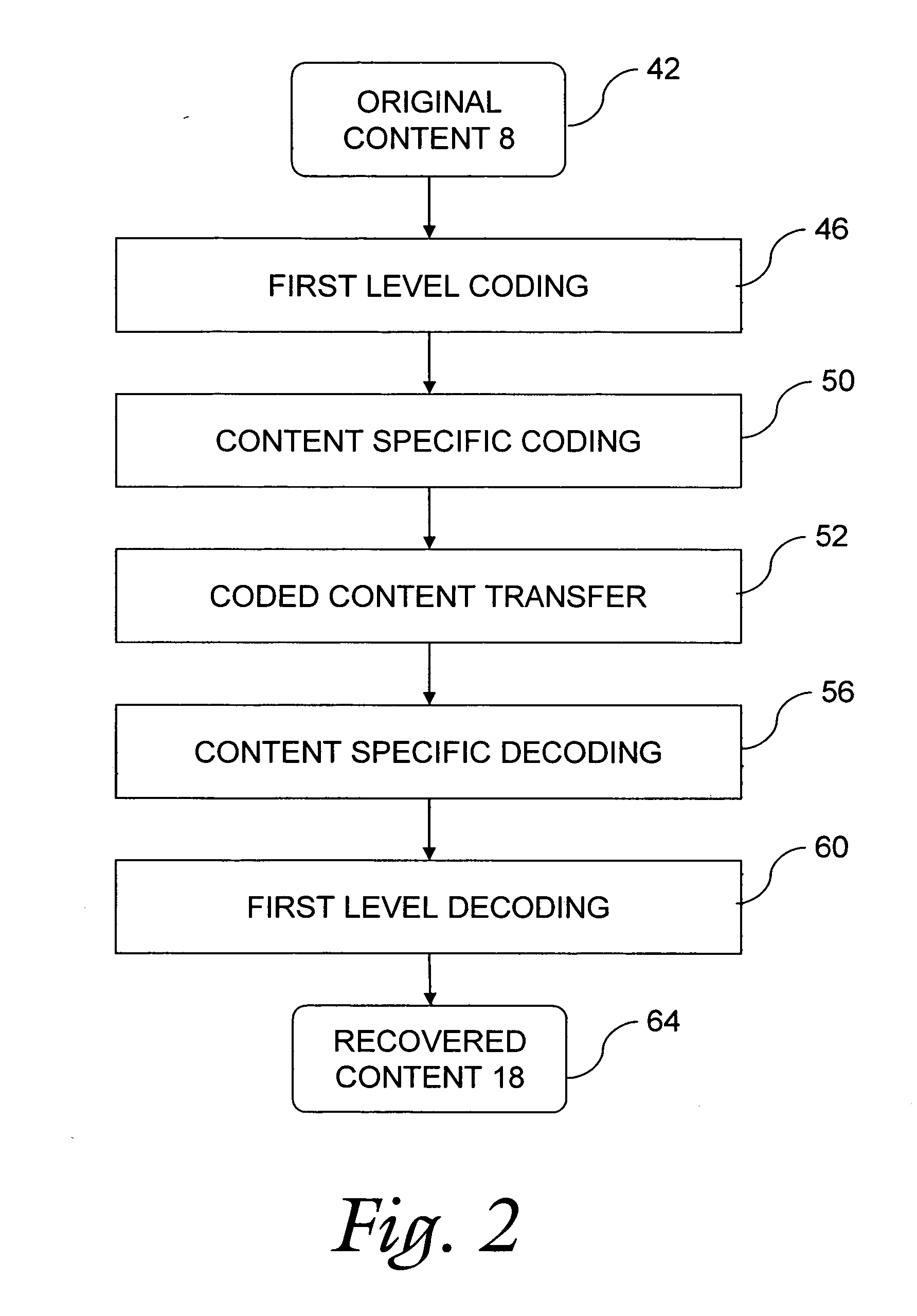[0011] In accordance with one embodiment of the invention, the content to be shared among the users is encoded using a content-specific encoding mechanism to enhance the transportability of the content across the communication medium. For example, in one embodiment, the encoding can comprise algorithms for compression of the content to decrease the
file size of the content to be transferred across the communication medium. To further enhance the transportability of the
media content across the communication medium, this content-specific encoding can be performed in addition to or on top of another step of encoding performed on the content. Thus, for example, content-specific encoding can be performed on content that is already compressed using an alternative
encoding algorithm. As such, in this example, the content-specific encoding can further compress the
media content, thus allowing improved transportability across the communication medium.
[0014] In one embodiment, communication of the encoded content can be accomplished using conventional e-mail
delivery methods. Alternatively, in another embodiment, delivery of the content can be accomplished using one or more special purpose servers. While the special purpose servers are not necessarily dedicated servers, they include
software or other functionality to enable transferring the content in accordance with the one or more embodiments described herein. For example, a
server can be included to accept content carrying messages from a sending user and
route those messages to one or more designated recipients. The
server can be implemented, if desired, with constraints placed on
message size relaxed or even eliminated, thus diminishing or removing the size barrier often found in some conventional e-mail servers. Thus, this is one way the use of a
content server can allow greater flexibility in delivery of messages to one or more recipients.
[0020] In accordance with yet another embodiment of the invention, a
content sharing application can be implemented to identify one or more content components that may be included in a content item, and apply content-specific encoding to one or more of these components to thereby enhance the encoding of the content overall. For example, the original content may comprise a document file that includes text,
graphics, and audio components. In accordance with this embodiment of the invention applied to this example, the
content sharing application can be implemented to identify the
content type of each of these components and apply the appropriate encoding schemes to optimize or enhance the overall compression of the document file.
[0021] The invention can be implemented such that some or all of the decoding and encoding schemes can provide lossless, or perceptibly lossless, encoding and decoding to enhance the quality of the recovered content at the recipient's end. In one embodiment, options can be provided to users such that a level of losslessness can be selected enabling the user to make an appropriate trade-off between
reproduction quality and transferability.
[0026] Along with installing any associated
software, the server can collect useful information and enable the creation of an account (in systems where accounts are utilized to manage various users) for the recipient. As such, in accordance with this embodiment, a user can send a content message to a recipient without having to first determine whether the recipient has the necessary
software installed on his or her
machine and can send this message using the recipient's conventional e-
mail address, which is used by the server to deliver the installation instructions (which in one embodiment is simply a text-based web link, button, icon or other item) to the recipient. Likewise, upon
receipt of the introductory message, the recipient can, with little effort, download and install any appropriate software and begin receiving content from the sending user.
[0027] In accordance with yet another embodiment of the invention, one or more graphical user interfaces (GUIs) can be provided to give the application or applications a desired
look and feel. For example, in one implementation, the GUIs used provide the application with a
look and feel similar to that of conventional e-mail applications. As such, a new user to the
system can become easily acclimated to the dialog boxes provided to enable the management, transmission, and
receipt of various content items. Of course, other looks and feels can be produced and provided, as it is not necessary that the application have the
look and feel of an e-mail application.
 Login to View More
Login to View More  Login to View More
Login to View More 


